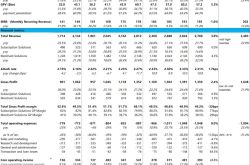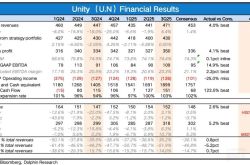Intel's Layoffs and Cost Cuts Show Initial Results, Yet Growth Remains Elusive
![]() 02/05 2025
02/05 2025
![]() 389
389
Intel released its financial report for the fourth quarter of 2024 (ending December 2024) after the U.S. market closed on January 31, 2025, Beijing time. Here are the key highlights:
1. Core Data: Enhanced Operational Performance
Intel generated revenue of $14.26 billion in the fourth quarter of 2024, a 7.4% year-on-year decline but in line with market expectations ($13.82 billion). This decline was mainly due to the contraction in the client business and the data center and AI business. Intel's net profit for the quarter was -$126 million, nearing the breakeven point. Operationally, the company's operating profit rebounded significantly, primarily due to the effectiveness of cost-cutting measures.
2. Business Conditions: AI Business Struggles to Achieve Breakthroughs
Client business and data center and AI business are Intel's primary revenue sources, collectively accounting for over 80% of total revenue.
- Client Business: Revenue for this quarter was $8.017 billion, a 9.4% year-on-year decline but in line with market expectations ($7.88 billion). Despite a 3.4% year-on-year increase in PC industry shipments, Intel's related business declined by 9.4%, indicating a further erosion of market share.
- Data Center and AI Business: Revenue from the data center and AI business (including Altera) for this quarter was $3.816 billion, a 4.2% year-on-year decline but in line with market expectations ($3.813 billion). Both the traditional server business and the Altera business declined this quarter, failing to benefit from the growth of the AI industry chain.
3. Intel's Financial Guidance:
The company expects revenue for the first quarter of 2025 to be $11.7-$12.7 billion (market expectation of $12.84 billion) with a GAAP gross margin of 33.8% (market expectation of 36.4%). Both the revenue and gross margin guidance ranges are slightly below market expectations.
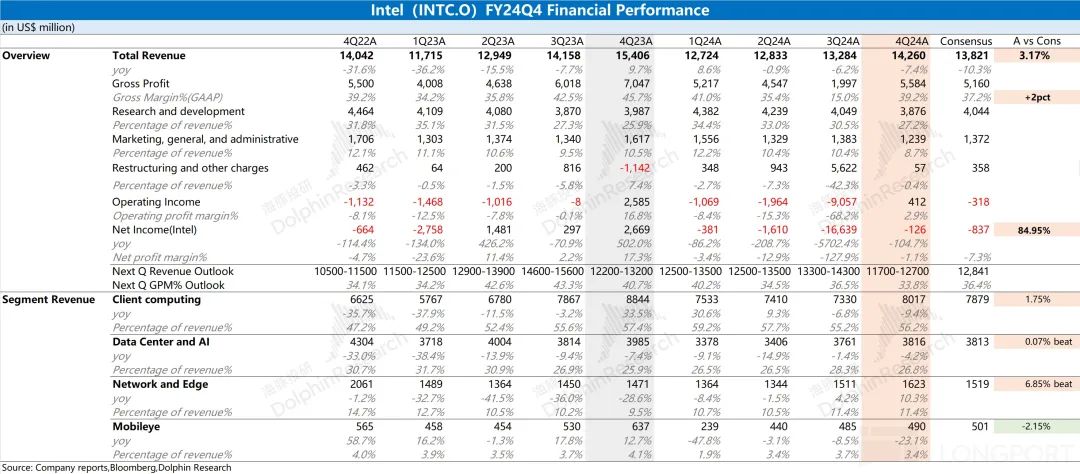
Dolphin's Overall View: Intel's financial report this time is not discouraging.
While the company's revenue and gross margin for this quarter declined, they met market expectations. The market had anticipated weakness in Intel's client business and lack of growth in the data center and AI business. Given that this report did not show "worse" performance, it is still considered satisfactory.
For the next quarter, Intel expects revenue of $11.7-$12.7 billion and a GAAP gross margin of 33.8%. Although both core data points declined, the overall situation remains acceptable. As long as there is "no collapse," the market has a high tolerance for the company's current business performance.
For Intel, the market is currently most concerned about the progress of internal reforms. The company replaced its CEO in December and initiated business adjustments. With operational development hindered, Intel's main focus has been on cutting capital expenditures, laying off employees, and reducing costs to improve its financial health.
From this quarter's financial report, these measures have indeed been effective. The company's workforce has significantly decreased from 124,000 at the end of the previous quarter to 109,000. Layoffs and cost reductions have had an "immediate" impact on the company's operating expenses. Core operating expenses for this quarter decreased by $320 million compared to the previous quarter, significantly boosting the company's operating profit.
Intel's share price has been declining since 2021, and the company has not benefited significantly from the AI wave during this period. With struggles to enter the GPU market, Intel's market share in the CPU market is gradually eroding. The continuous decline in share price has gradually diminished confidence in the company's entry into the AI incremental market. The market's current focus on Intel has shifted to whether it can stabilize its core business and achieve a performance recovery. The current layoffs and cost reductions are also the main focus of the company's internal reforms.
Overall, while Intel's business does not show significant growth, its core operating expenses have begun to narrow. In the short term, the company's performance will remain at a low level, and it will be difficult to improve significantly. For medium to long-term growth, it is crucial to monitor the company's breakthroughs and progress in the field of computing power chips or foundry services. If Intel continues to struggle to enter the main battleground of computing power, cost reduction and expenditure control can only stabilize the company's declining trend but cannot bring more growth opportunities.
Below is a detailed analysis:
I. Core Data: Enhanced Operational Performance
1.1 Revenue:
Intel generated revenue of $14.26 billion in the fourth quarter of 2024, a 7.4% year-on-year decline but close to the upper limit of the company's guidance ($13.3-$14.3 billion). Although the fourth quarter is typically a busy season for the company, quarterly revenue still declined year-on-year, mainly due to the contraction in the client business and the data center and AI business.
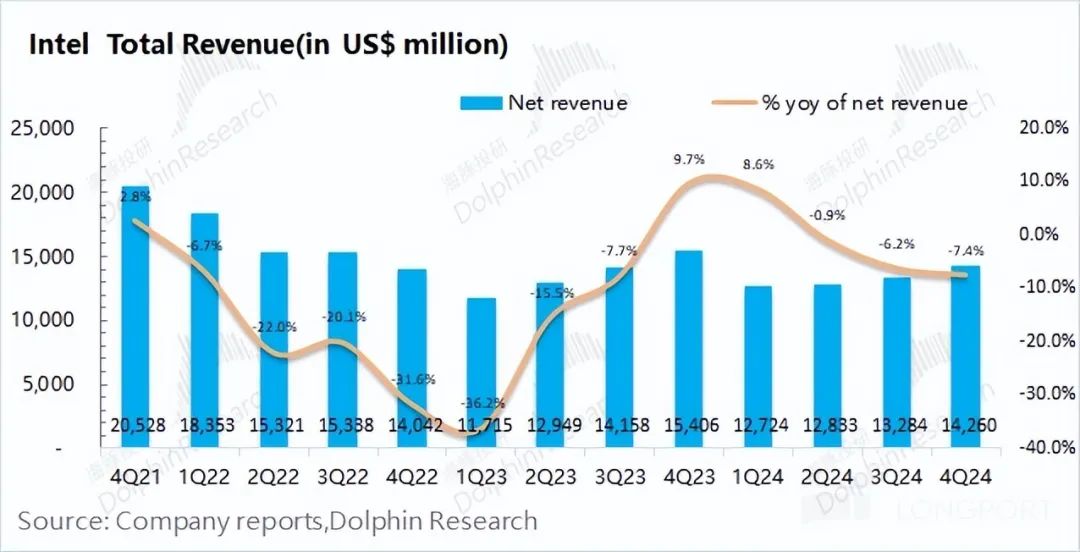
1.2 Gross Profit and Gross Margin:
Intel achieved a gross profit of $5.584 billion in the fourth quarter of 2024, a 20.8% year-on-year decline. From a business perspective, the company's current profits still mainly stem from the PC client business. In terms of gross margins, the company's gross margin for this quarter was 39.2%, a significant rebound from the previous quarter and better than market expectations (36.5%). The "flash crash" in the company's gross margin in the previous quarter was primarily due to one-time impairment charges (approximately $3.1 billion). Excluding this impact, the actual operating gross margin for the previous quarter was 38.4%, and this quarter's gross margin has still increased.
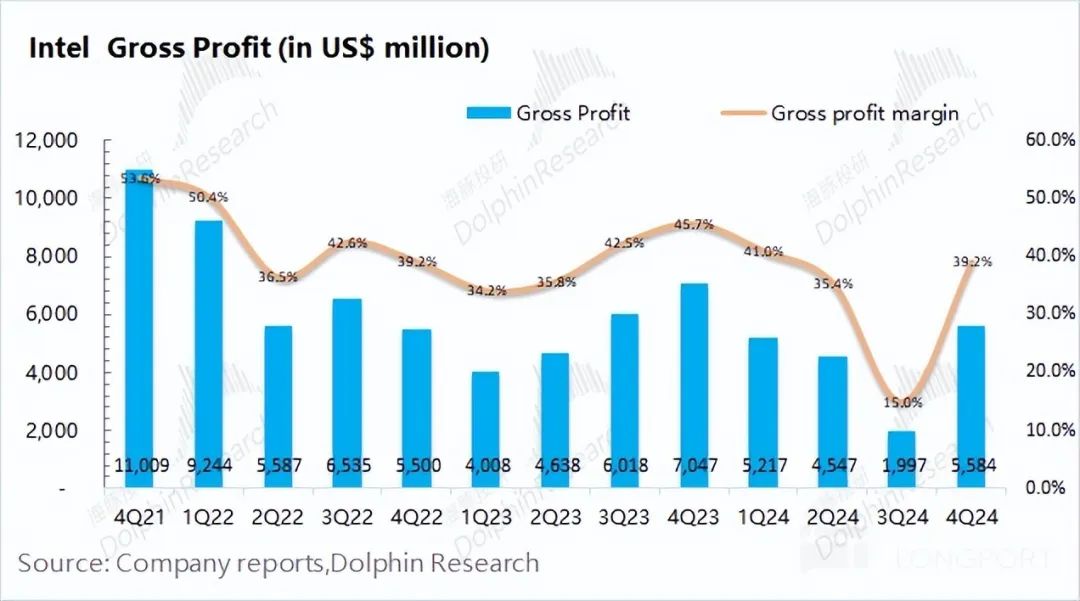
1.3 Operating Expenses:
Intel's operating expenses in the fourth quarter of 2024 were $5.172 billion, a 15.9% year-on-year increase. Excluding restructuring and other impacts, the company's core operating expenses (R&D + sales and administration) declined significantly, mainly due to layoffs and cost reductions (employee count decreased from 124,000 at the end of the previous quarter to 108,900 currently).
- R&D Expenses: R&D expenses for this quarter were $3.876 billion, a 2.8% year-on-year decrease, with an R&D expense ratio of 27.2%. The company began staffing adjustments in the third quarter, and R&D expenses for this quarter have already decreased compared to the previous quarter, but they are still the largest item in the company's operating expenses.
- Sales and Administration Expenses: Sales and administration expenses for this quarter were $1.239 billion, a 23.4% year-on-year decrease; the sales and administration expense ratio decreased to 8.7%. The company's sales and administration expenses decreased significantly, mainly due to recent layoffs and other operational measures.
- Restructuring and Other Expenses: The company's restructuring and other expenses for this quarter were $57 million. The "positive offset effect" in this expense category for the same period last year was due to progress in litigation and other events. Restructuring and related expenses were relatively stable this quarter.
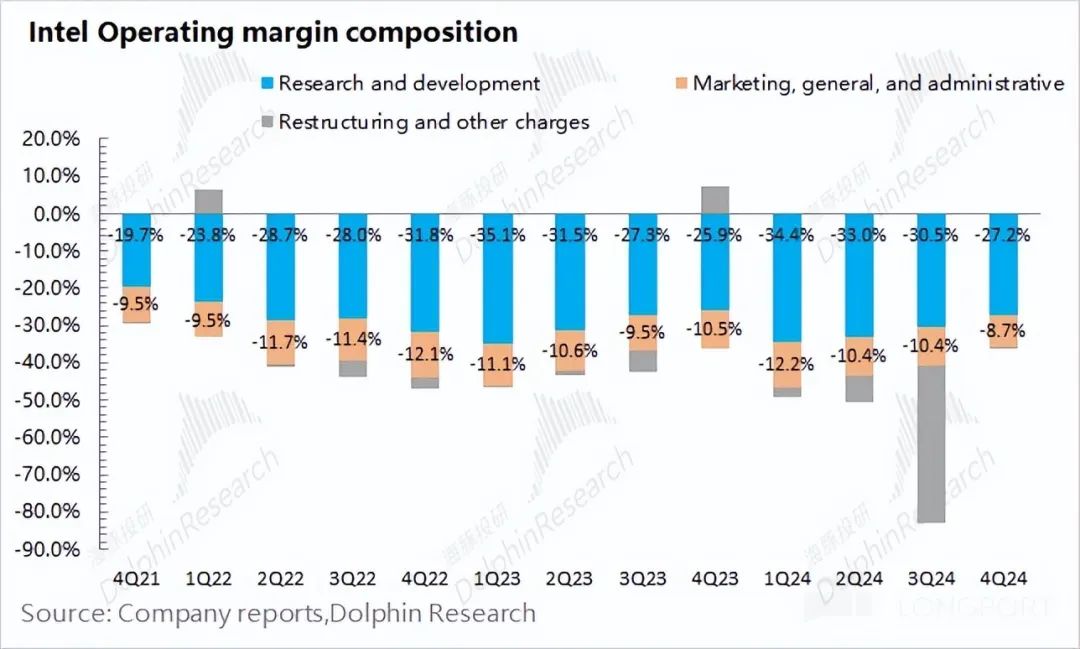
1.4 Net Profit:
Intel's net profit in the fourth quarter of 2024 was -$126 million, nearing the breakeven point. The company's huge loss in the previous quarter was mainly due to multiple one-time expenses (including impairment charges on manufacturing assets such as production lines, restructuring expenses, goodwill and intangible assets, and valuation allowances for deferred tax assets), totaling $18.5 billion, which significantly impacted performance. From an operational continuity perspective, the company's operating profit in the previous quarter was -$140 million, while this quarter's operating profit increased to $412 million, mainly due to the rebound in the company's gross margin and the effectiveness of layoffs and cost reductions.
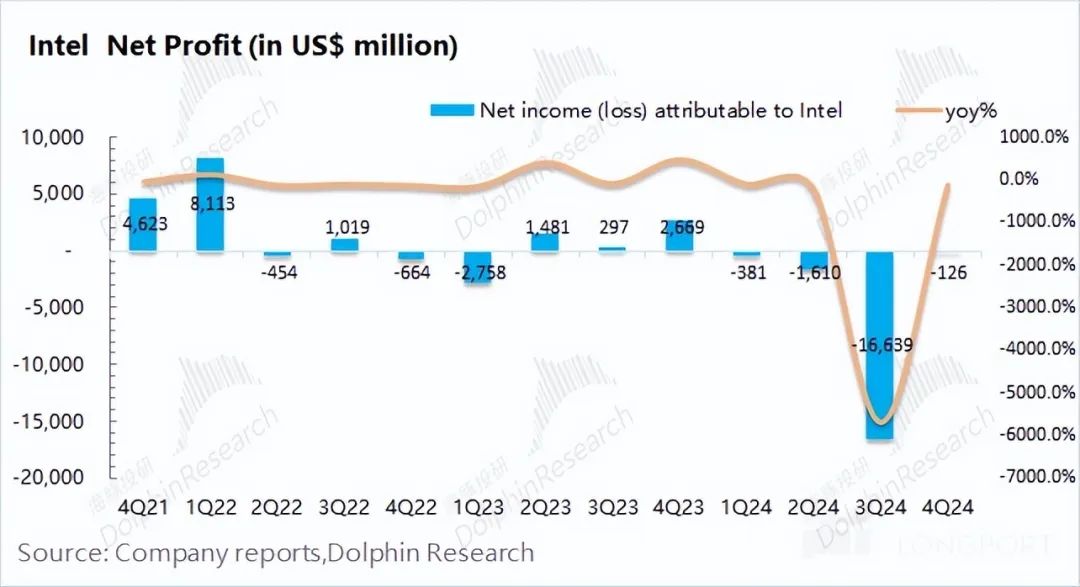
II. Segmented Data: AI Business Struggles to Achieve Breakthroughs
Intel's business comprises client business, data center and AI, network and edge domains, Mobileye, and foundry services. Among these, client business and data center and AI business are the company's primary revenue sources, collectively accounting for over 80% of total revenue.
The company began adjusting its reporting again from the first quarter of 2024, separating Altera's business income from the data center and AI and rewriting Intel's external foundry income as foundry income and internal business offsets. For data continuity, Dolphin still analyzes it based on the original business structure.
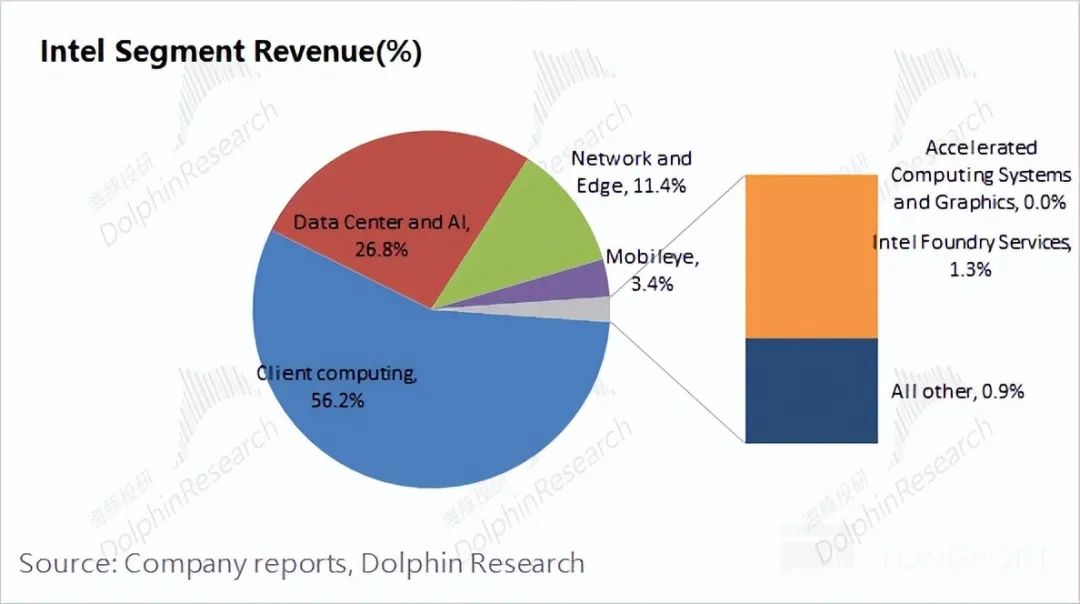
2.1 Client Revenue
Intel's client revenue in the fourth quarter of 2024 was $8.017 billion, a 9.4% year-on-year decline but basically in line with market expectations ($7.88 billion). Due to the high proportion of client business, this was the primary factor for the company's revenue decline this quarter.
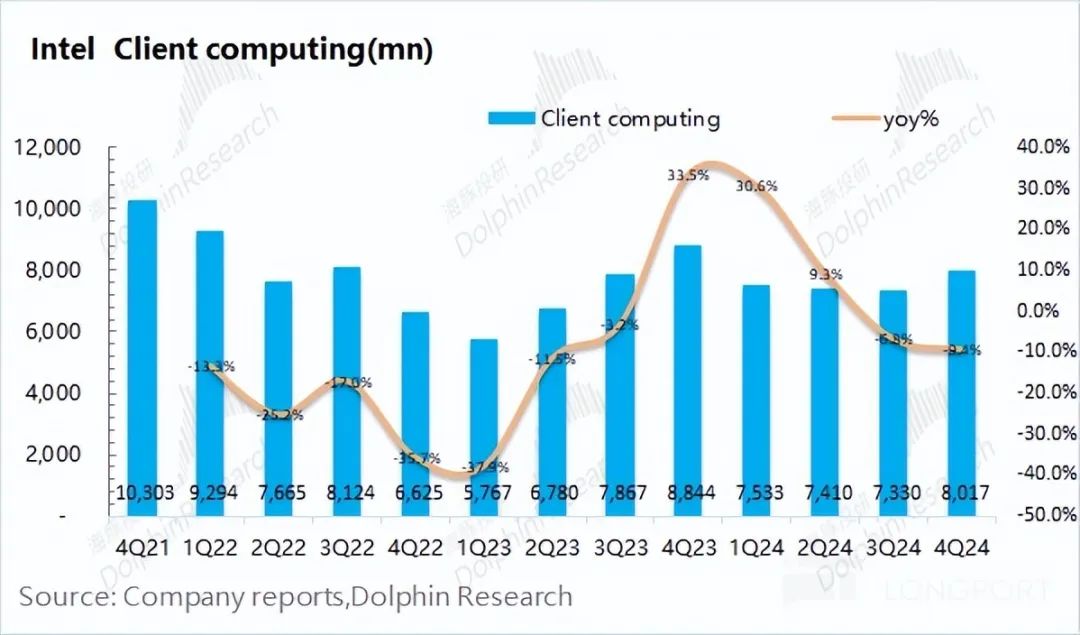
According to IDC industry data, global PC shipments increased steadily this quarter. Global PC shipments for this quarter were 69.3 million units, up 3.4% year-on-year.
Comparing them together, in the PC processor market: industry-wide shipments increased by 3.4%; Intel's quarterly revenue in the PC segment decreased by 9.4%. It is evident that while PC industry demand has increased steadily, Intel's related business has continued to decline, and the company is still losing relevant market share.
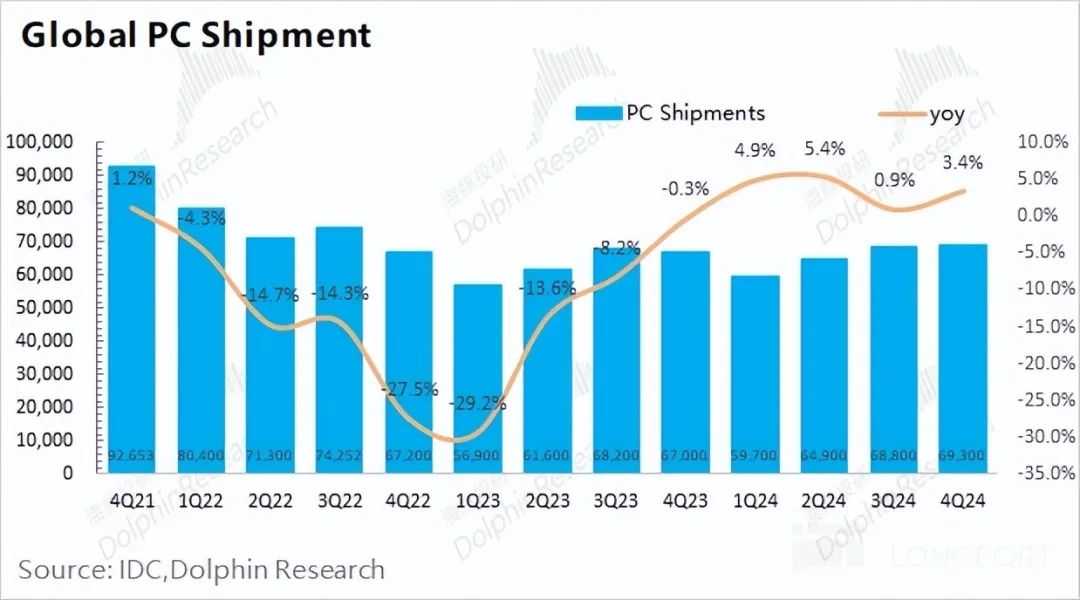
2.2 Data Center and AI
Intel's data center and AI revenue in the fourth quarter of 2024 was $3.816 billion, a 4.2% year-on-year decline.
After separating the Altera business from the data center and AI business, the company's pure data center and AI business for this quarter was only around $3.387 billion, down 3.3% year-on-year, mainly due to the continued weak demand for traditional servers this quarter.
For data continuity, Dolphin still looks at it from the original business division. The company's overall data center and AI business declined by 4.2% year-on-year. Among them, the traditional server business declined by 3.3% year-on-year, and the Altera business declined by 11%. Compared to rapidly growing peers (NVIDIA & AMD), Intel's business has declined.
The current demand for the data center and AI market is mainly concentrated in the GPU and ASIC fields. Even the new demand for CPUs brought about by AI has been filled by competitors' bundled CPU/GPU product combinations. As Intel struggles to overcome GPUs, ASIC players have also begun to enter the market, and Intel is moving further away from the main track of data centers.
For the data center market, the main focus is on the capital expenditures of the four major core cloud vendors (Microsoft, Google, Meta, and Amazon). So far this quarter, only Meta and Microsoft have announced their latest capital expenditures, totaling $37.4 billion, up 92.7% year-on-year. In addition, the two companies also have a positive outlook for subsequent capital expenditures. Dolphin estimates that the combined capital expenditures of the two companies will still grow by nearly 40% next year.
Although there is still good demand in the data center market, Intel has basically withdrawn from competition in the incremental market.
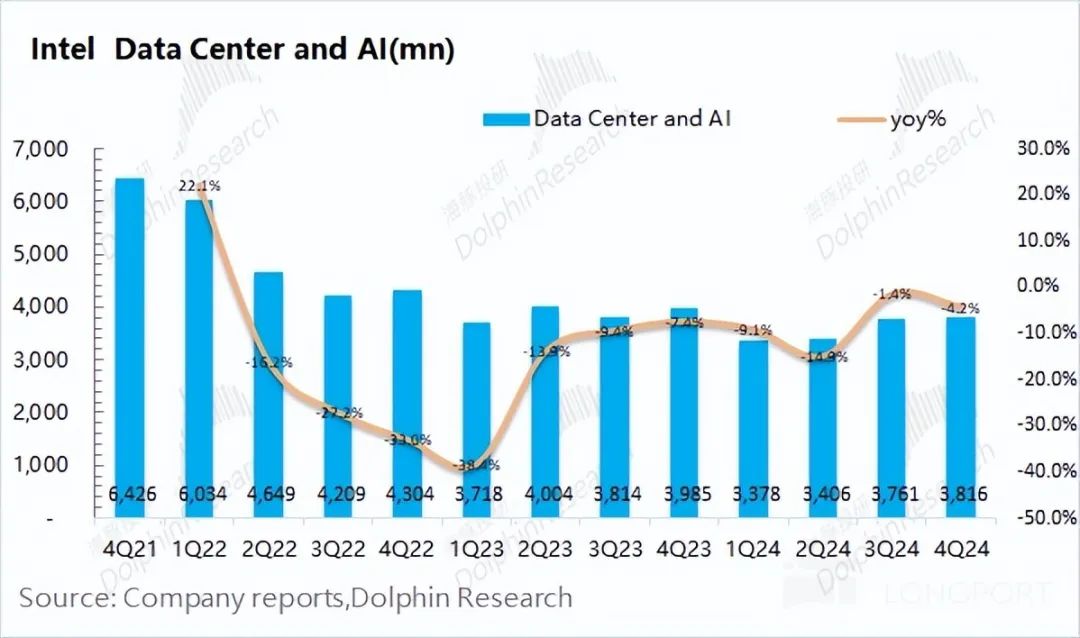
2.3 Network and Edge Domains
Intel's network and edge domain revenue in the fourth quarter of 2024 was $1.623 billion, up 10.3% year-on-year, accounting for only 10% of total revenue. After customer inventories returned to normal levels, the company's network and edge domain business rebounded from the bottom, and the company shifted the focus of this business to networks and telecommunications.
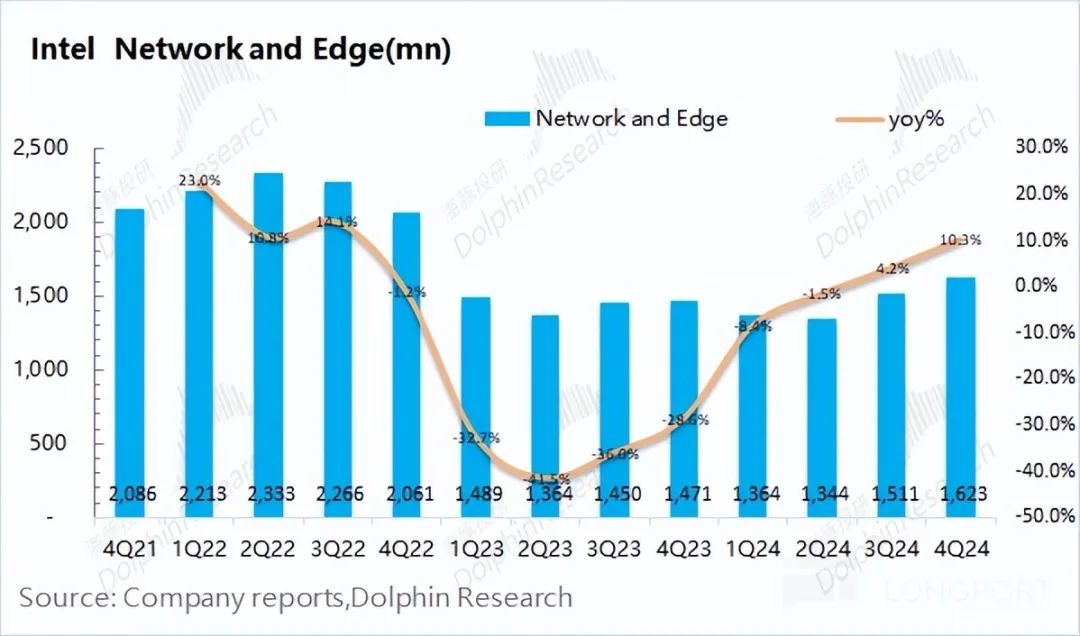
2.4 Other Major Businesses
- Mobileye: Intel's Mobileye revenue in the fourth quarter of 2024 was $490 million, down 23.1% year-on-year, accounting for less than 5% of total revenue. Although this quarter's decline was affected by a more than 50% reduction in shipments to China, the company still maintained its full-year revenue guidance.
- Foundry Outsourcing Services: Intel's foundry outsourcing service revenue reached $191 million in the fourth quarter of 2024. This quarter, the company re-disclosed its foundry business, including both foundry operations and internal offsets. Dolphin Insights combined these two aspects to estimate the company's external foundry service situation. This quarter, the company's external foundry services have rebounded, but their proportion still only accounts for 1.3%, having a relatively small impact on the company's performance.
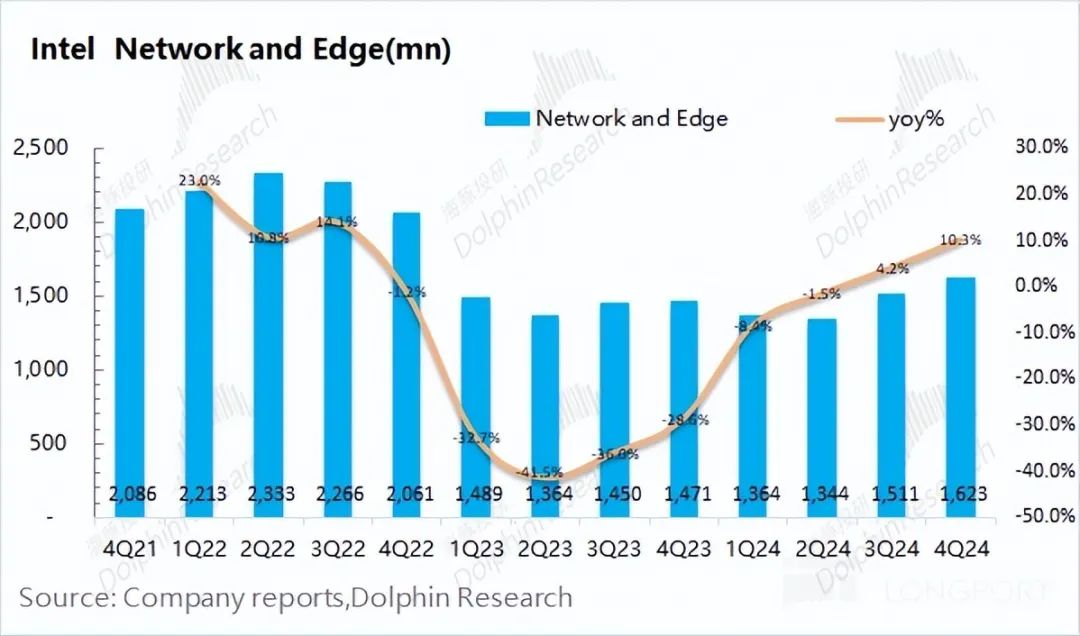
- END -
// Repost with permission


